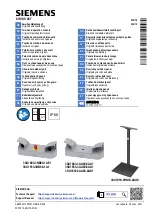
Allen & Heath
17
WZ
4
16:2 and 12:2 User Guide
The STEREO Input Channel
(WZ
4
12:2 only)
Dual stereo inputs
Each of the two stereo channels has two stereo inputs
which can be used separately, mixed together or split so that one feeds the
channel, the other routes direct to LR. For example, you could mix two sound
effects playback devices or two reverb returns together into one channel. This
can be useful in saving channels, letting you mix many inputs in a small space.
The L input signal normals through the R input socket so that a mono source
may be plugged in to feed both left and right sides of the stereo channel.
ST1 (ST3)
Unbalanced TRS inputs. The GAIN control adjusts from fully off
to +16dB gain. Press the ST1 (ST3) switch to turn the input on.
Routing mode switch
Recessed switch to prevent accidental operation. In
the normal up position the ST1 (ST3) signal mixes with ST2 (ST4) into the
stereo channel. When pressed the signal is routed direct to the LR mix instead
of the channel. This lets you use these inputs as simple stereo returns in addi-
tion to the full stereo channels, providing four independent stereo sources to
the LR mix.
ST2 (ST4)
Balanced TRS inputs. The GAIN control adjusts from fully off to
+16dB gain. Press the ST2 (ST4) switch to turn the input on. These inputs
always feed the stereo channels.
EQ
A 4-band fixed frequency EQ provides independent control of four fre-
quency bands. HF and LF are shelving filters which affect high frequencies
above 12kHz, and low frequencies below 80Hz respectively. HM and LM are
bell shaped peak/dip filters which affect frequencies centred around 2.5kHz and
250Hz respectively. These have a width (Q) of 1.8. All bands can be boosted
or cut by up to 15dB and have a centre detented 0dB position.
AUX SENDS
These work as described for the mono channel. The L and R
sides of the stereo signal sum together to feed each aux in mono. This can be
changed using an internal solder option so that L feeds auxes 1,3 and R feeds
auxes 2,4.
BAL
Balances the level of the L signal against the R signal to compensate for
differences in the source signal, or to position the signal within the stereo im-
age. The centre equal level position is detented for quick resetting.
MUTE
When pressed the channel signal is turned off. This affects the feed
to the LR mix, and pre and post-fade aux sends. The red indicator lights when
the channel is muted.
PFL
Press PFL to listen to the summed L+R pre-fade channel signal in the
headphones or AB monitor (if configured) without affecting the main outputs.
The console main LR meters are interrupted with the channel signal. The red
PK indicator half lights to show that PFL has been selected on that channel.
PEAK
The red indicator illuminates when the channel pre-fade signal is within
5dB of clipping. This gives you enough warning to reduce the GAIN control
before you hear signal distortion.
SIGNAL
The green signal presence indicator lights when the channel pre-
fade signal is greater than -12dBu.
FADER
Controls the channel level feeding the main LR mix and post-fade aux
sends. It also affects the direct output if this has been set to post-fade using the
internal option jumper. The fader provides +10dB maximum boost above its
normal unity gain 0dB position.
10
5
0
5
10
30
20
SIG
POST
POST
PK!
BAL
6
AUX
AUX
5
MUTE
PFL
L
R
+6
+6
PRE
AUX
AUX
4
3
AUX
2
AUX
1
+6
+6
+6
+6
ON
ON
(ST1+ST2)
TO
9-10
LR
TO
LF
LM
HM
HF
-5
GAIN
-10
-20
5
10
16
0
-5
GAIN
-10
-20
5
10
16
0
EQ IN
OO
O
O
O
O
O
O
O
O
O
O
O
O
USO
RESTRITO
















































